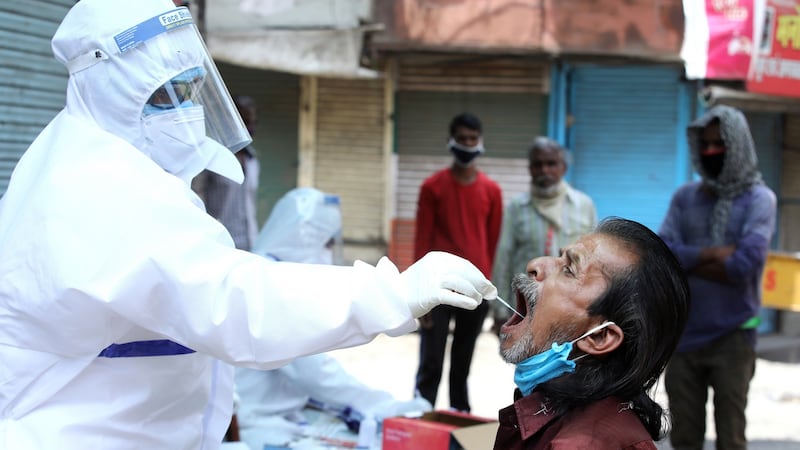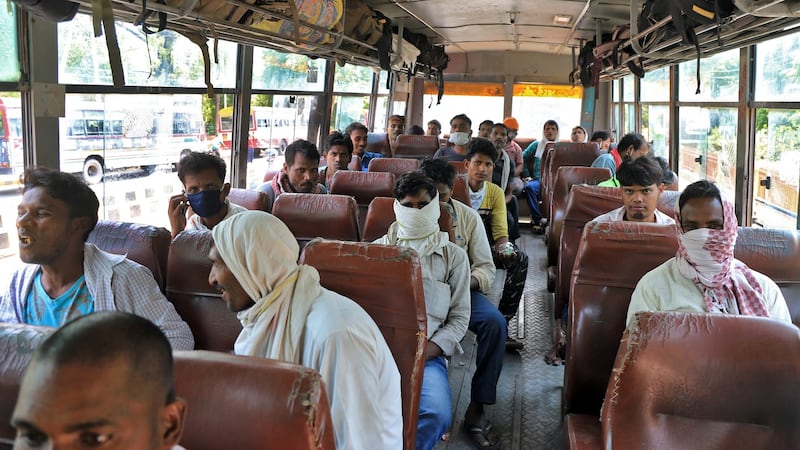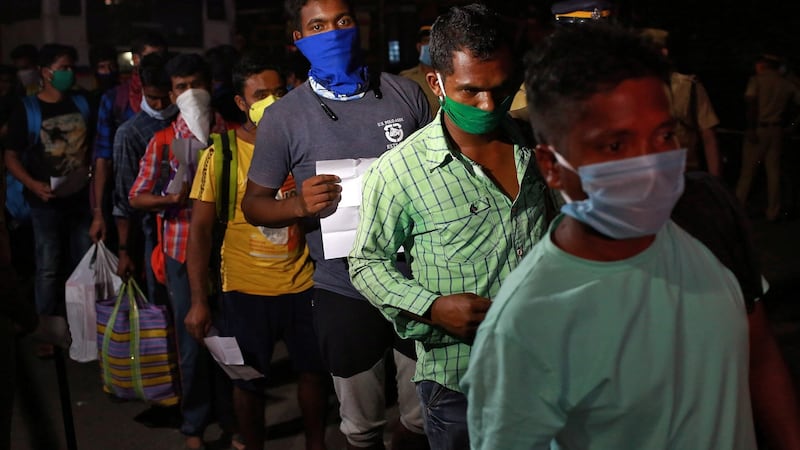Gopal Das has laboured on construction sites in Mumbai for nearly two decades, helping build the office towers of India's bustling financial capital. Though the rural migrant's average monthly earnings were just Rs10,000 (€120), most was sent home to support his wife, two teenage children and ageing parents in the impoverished state of Bihar.
But for the past six weeks, Das has felt less like a worker and more like a beggar, struggling to get by without wages during India’s strict anti-coronavirus lockdown. Trapped in Mumbai after a failed effort to get a train home before all public transport was suspended on March 22nd, the 41-year-old has relied on daily food handouts to survive in the Bandra slum, where he shares a single room with five others.
Some days, the labourer – who had just Rs500 in his hand when curfew was imposed – receives a daytime meal from a nearby temple, or charities that occasionally distribute food. Otherwise, he depends on the police, who come to the area most evenings to dish out boiled rice and dal to the hungry, restless residents. He says he has not had a cup of tea since lockdown began.
“I never thought I would have to live like this and depend on people’s charity for food,” Das says.
He has just one goal now: escape the city and get back to his village and family as soon as possible. Once there, he says, he will not think of returning to the city for at least a year – no matter how tough conditions are at home. “I will not put myself through such humiliation again,” he says. “I had never slept on an empty stomach in Mumbai before. But the curfew made me realise, ‘the city doesn’t care’.”
Das's ordeal is typical of the tribulations that India's estimated 170 million financially fragile, blue-collar and gig economy workers have endured since late March, when prime minister Narendra Modi overnight imposed one of the world's strictest lockdowns to slow the spread of coronavirus.
Life has never been easy for India’s vast army of working poor – self-employed and casual labourers who typically work on short-term contracts, with little security. But with toil and frugality, they and their families have managed to survive. Now, though, with economic activity at a standstill, most have seen their incomes collapse to zero. The Centre for Monitoring the Indian Economy (CMIE) estimates about 140 million people have lost jobs, pushing the unemployment rate up to 26 per cent from 8 per cent before the crisis.
‘Hunger pandemic’
Indian workers – and those who depend on them – are not alone in their hardship. Shutdowns to control the deadly pathogen have sparked food riots in countries such as South Africa and fuelled protests elsewhere, including Lebanon. The UN warned last week that the world faced a "hunger pandemic", with millions facing starvation.
Even before the pandemic, about 250 million Indians were not getting enough to eat, the UN's World Food Programme estimates. Stunting and wasting – symptoms of both chronic and acute hunger – were already afflicting millions of Indian children. Now, economists and social activists warn that India is facing a severe humanitarian crisis, unless desperate workers are either permitted to start earning money again, or provided with substantive government relief to cope with the calamitous loss of income.
To get by, working-class Indians have pared their diets, drawn down meagre savings, borrowed from money lenders and collected food handouts from charities and impromptu groups of citizens alarmed at the distress. In big cities, temporary community kitchens and food distribution centres – run by state and local officials, politicians, charities and even Modi’s ruling Bharatiya Janata party – have drawn long queues, evocative of the breadlines and soup kitchens of the Great Depression.
"The scale of the humanitarian disaster is significant," says Pratap Bhanu Mehta, a political-science professor at Ashoka University. "While everyone understands the need for the lockdown, millions of workers were needlessly stripped of their dignity."
‘Green zones’
After six weeks of the shutdown, Modi’s administration is weighing the benefits of restarting the stalled economy against the looming threat of the virus, which is so far known to have infected more than 31,000 people in the country, leaving more than 1,000 dead.
New Delhi hopes to encourage economic activity in so-called "green zones" – districts with no sign of the virus, especially rural areas – while maintaining tight restrictions in "red zone" big cities such as Mumbai and Delhi and industrial hubs such as Surat in Gujarat where there are rising caseloads. Most public transport will remain suspended to prevent intermingling of people from different zones.
But industry groups warn that such a geographic segregation is unlikely to work well, as supply chains and labour markets will still be severely disrupted.

"[They face] a horrible trade-off," says Tarun Ramadorai, an economics professor at Imperial College London. "Ease the lockdown so people can get out there and earn an income . . . [or] provide fiscal support so that people can stay at home. Either way, you will face the costs."
So far, Modi's government has provided relatively little succour to its most vulnerable citizens. While other countries have rolled out massive relief packages to cushion families and businesses from the economic shock of coronavirus, New Delhi has largely left the population to fend for itself as it frets about its own finances, already weakened by the previous two years of a protracted economic slowdown.
‘Make up their mind’
“They seem to think that Indians are used to pain; they are used to hunger and as the economy opens up the pain and hunger of the last month will be forgotten,” says former finance minister P Chidambaram, of the opposition Congress party. “They have to first make up their mind whether they will do whatever it takes to mitigate the pain and hunger and starvation of people.”
Yet former revenue secretary NK Singh, like Modi a member of the BJP, says New Delhi has little room for manoeuvre. Meeting this year’s fiscal deficit target of 3.5 per cent of gross domestic product already appears impossible given likely growth and revenue shortfalls, while the limited scope for fiscal measures leaves little space for stimulus. Analysts warn of the risk that India will face of a downgrade of its sovereign rating if its public finances weaken.
“This current political leadership will not give in to the macroeconomic temptation for fiscal profligacy,” says Singh. “It is quite conscious of our vulnerabilities, and how these things can get out of hand. Maintenance of macroeconomic stability must be the cardinal principle.”
Of the $22 billion “relief package” unveiled in late March, much of it was accelerated disbursement of expenditure already budgeted for the year.
New Delhi is providing small one-off cash transfers of Rs1,000 each to 30 million senior citizens and disabled people, and Rs1,500 each to 200 million rural women with no-frills bank accounts. It is also donating 5kg of free wheat or rice each month for the next three months to poor people who were already entitled to subsidised food through the country’s public distribution system.
But these measures offer little solace to stranded migrants, whose food benefits are typically collected by families back home. Nor will it help the likes of Aruna Mishra, a 36-year-old private tutor who has never needed subsidised food before but is desperate for it now. She does not know when she or her husband – a store manager in a working-class district on the outskirts of New Delhi – will ever get paid again.

“On TV, they keep saying the government is providing dry food rations to people like us,” says Mishra, a migrant from Bihar. “Twice my husband has been turned down; they said bring your ration card. Our situation is very bad. We have no savings. We are on the brink of starvation. I have lost so much sleep thinking what will we do if we can’t go home.”
Many economists believe New Delhi must do more to cushion vulnerable families at risk of sliding into poverty. In rural areas, the demand to participate in a workfare scheme has begun to soar. Other relief could include tapping the country’s massive grain stockpile to distribute free or low-cost rice and wheat to all who want it, rather than just poor households already eligible before the pandemic struck, and cash transfers.
“India has done almost nothing on the fiscal front to save people from complete destitution,” says Mahesh Vyas, CMIE managing director. “They will not lift the lockdown, and they will not help the poor.”
The state-owned Food Corporation of India has some 77 million tonnes of cereals in stock, much of it now gradually rotting due to poor storage. But New Delhi is reluctant to distribute this widely, as it would bloat this year’s food subsidy bill. Instead, cash-strapped states have been invited to buy the food, at market rates, for their own local relief efforts.
“The government is clinging to this grain stock, hoping the states will buy it from them,” says Reetika Khera, an economist at the Indian Institute of Management Ahmedabad. “Their unwillingness to relent and give it free to the states is mind-boggling.”
Abhijit Banerjee, the Nobel Prize-winning economist, warns that if millions of households slide into chronic hunger and indebtedness they will be a drag on India’s economy for years.
“There has been a huge income shock to the people who are most illiquid and who will not be able to finance consumption by borrowing,” he says. “If they don’t revive their consumption, this then leads the whole economy to shrink. India should worry about a demand slump. Whenever the economy is allowed to revive, people will not have money to spend.”
Cash transfers, say advocates, would be a signal to struggling families that the government recognises their plight. “One of the important functions of government is to provide a certain kind of reassurance in the face of uncertainty,” says Mehta. “In the case of migrant workers this is almost a kind of existential uncertainty. They have zero savings. A cash transfer is an important signal of reassurance that their future will be taken care of, and that the government is working towards it.”
Jahangir Aziz, head of emerging market economics at JPMorgan, says New Delhi’s hesitation to do more to support its weakest may stem from its underestimation of the magnitude of the shock – and the arduous path to recovery.
“It is not a question of lack of resources, it’s a question of how do you see things,” Aziz says. “They are misjudging the impact of all of this. They don’t think the income loss is going to be as large as other people think it is.”
Even if India eases restrictions, the hardship for Das and others is unlikely to end quickly. Coronavirus "hotspots" that include some of the most economically dynamic regions will remain locked down for now. Social distancing – and public fears of falling ill – will constrain activity. Large companies may step up automation to reduce dependence on humans. Some export-oriented jobs will disappear, amid pervasive global economic gloom.

In these circumstances, Aziz believes concerns about fiscal rectitude are overdone. “The Indian policymakers are thinking within the established rules of the game,” he says. “Those tools – of inflation targeting, keeping your fiscal deficit within a very narrow range – all of this was meant to get credibility during normal times. But these are not normal times.”
For workers like Sannu Rahul, a 38-year-old migrant tailor at a factory in Tamil Nadu, help cannot come quickly enough. He has exhausted the Rs10,000 in savings he had when lockdown began, and has found it difficult to borrow more, as even traditional moneylenders are reluctant to extend credit in the current climate.
His former employer is pessimistic, and urging him to return to his home state of Orissa. "I think work should start again," he says. "It was going well here, but lockdown has destroyed us." – Copyright The Financial Times Limited 2020










